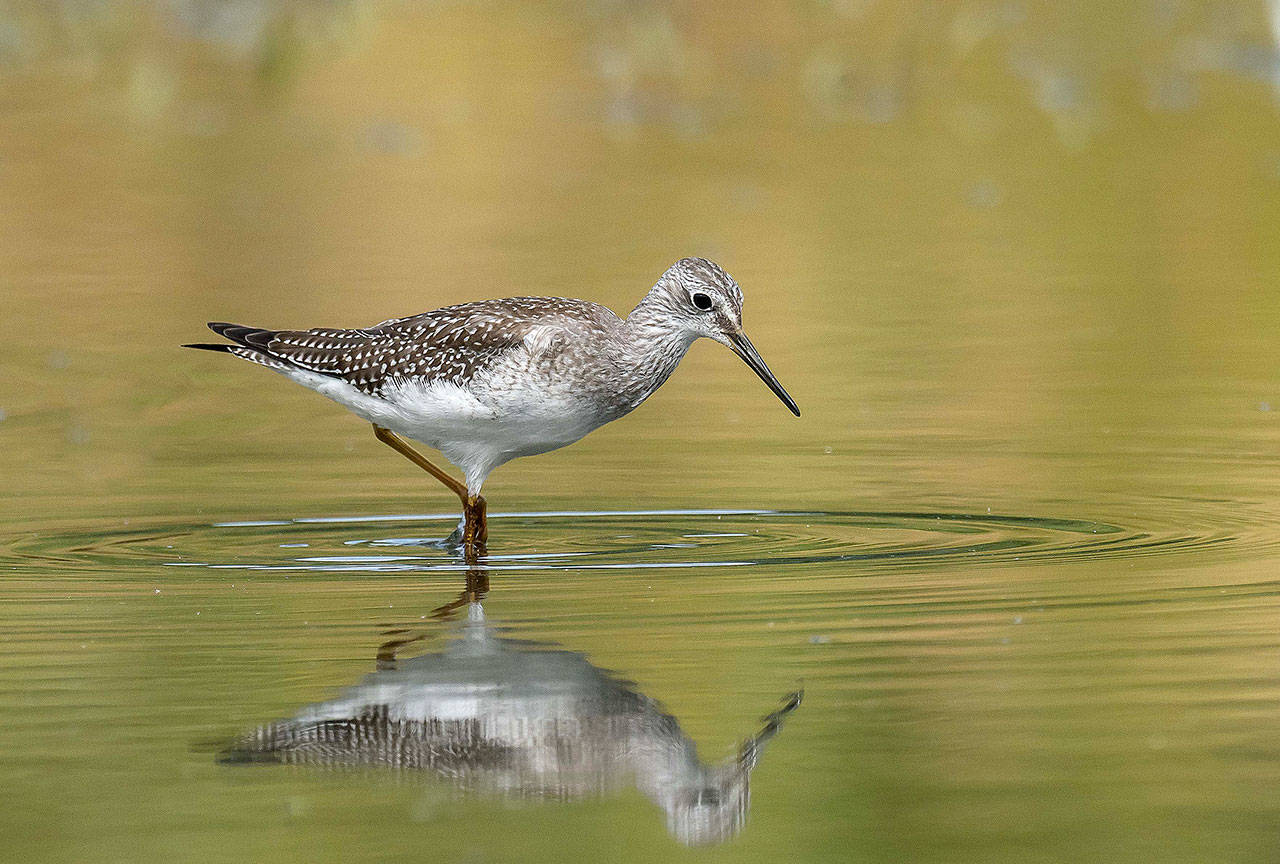By Dianna Moore
Grays Harbor Audubon Society
The end of the fall migration is upon us so this will probably be the last shorebird I feature this year and it’s a tough one to find. This smaller version of a more common to our area Greater Yellowlegs can be found throughout the state, especially during migration, but is often overlooked and mistaken for a Greater Yellowlegs. Unless they are standing side-by-side, it’s hard to distinguish the two from one another. The Lesser Yellowlegs is smaller of course, about one-third the size of the Greater Yellowlegs. The Lesser Yellowlegs bill is not too much longer than the length of it’s head front-to-back, while the bill of the Greater Yellowlegs is much longer. The bill of the Lesser Yellowlegs is also all black year-round, while that of the Greater Yellowlegs gradually lightens at the base. And in flight, the Lesser has a dark back, a white rump, and a dark tip on its tail. Photo credit is to Gregg Thompson.
General description: A medium-sized shorebird with long yellow legs, a straight, all black bill just a bit longer than the length of the head, white belly and rump, and a dark tip to it’s tail. It is approximately 10.5 inches in length, with a wingspan of 24 inches and weighs nearly 3 ounces.
Habitat: During migration and winter, they occur on coasts, in marshes, on mudflats, and lakeshores. In comparison to Greater Yellowlegs, Lessers are typically found in more protected areas, on smaller ponds. They are less common on extensive mudflats than Greater Yellowlegs. Lesser Yellowlegs breed in open boreal woods in the far north. They often use large clearings or burned areas near ponds, and will nest as far north as the southern tundra.
Behavior: Lesser Yellowlegs are more typically found in larger flocks than the Greater, both during feeding and in flight. Both forage in shallow water outside the breeding season, picking at prey on or just below the water’s surface. Lessers are more likely to swing their heads and bills from side to side to capture prey than the Greater Yellowlegs, which are more likely to run after their prey. They bob the front half of their bodies up and down, a characteristic behavior of this genus. And they are not as wary of humans as the Greater Yellowlegs….which are usually the first to raise the alarm when we arrive on scene.
Diet: Aquatic and terrestrial invertebrates, particularly flies and beetles. Occasionally small fish, crustaceans, and seeds.
Nesting: Lesser Yellowlegs form monogamous pairs, usually lasting just the one breeding season. They nest in loose colonies on the ground in a depression, and next to a clump of plants, a log, or fallen branch. The nest is lined with moss, twigs, leaves, grass, and needles. The parents incubate 4 eggs for 22 to 23. The young leave the nest soon after hatching and are able to forage for themselves. The parents then share the duties of aggressively defending the young until the female leaves after about 11 days. The male then tends the young until they can fly at about 23 to 31 days of age.
Migration: Lesser Yellowlegs follow the classic shorebird migration routes for northbound birds up through the center of the North American continent and spread out coast-to-coast for the southbound fall migration. They are definitely long-distance migrators, moving between the boreal forests of the north to the southern coastal areas of North America down to South America.
Conservation status: Despite reports of Christmas Bird Counts indicating that the wintering population in the United States is on the increase and that the population is currently stable, these numbers come from a small sample size and may not represent the entire population plus a lack of information on historical and current population size makes this claim hard to substantiate.
When and where to find on Grays Harbor: According to those who have studied these birds, the best times to see them has passed for now, with the fall migration winding down. July, August, and September are the best times to find them, usually out on the marshy edges of Grays Harbor itself. They can be seen at the local sewage lagoons, Oyhut Wildlife Area in Ocean Shores, and Bottle Beach State Park off Hwy 105 near Ocosta. Good luck!



